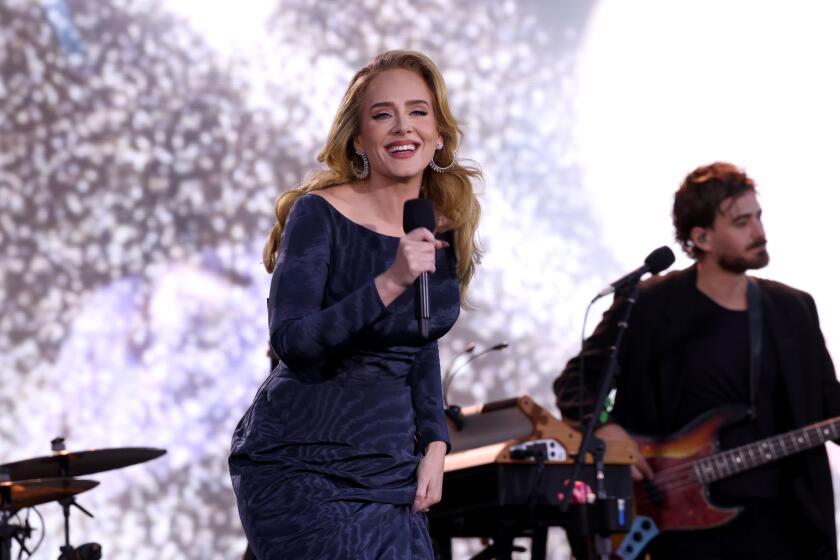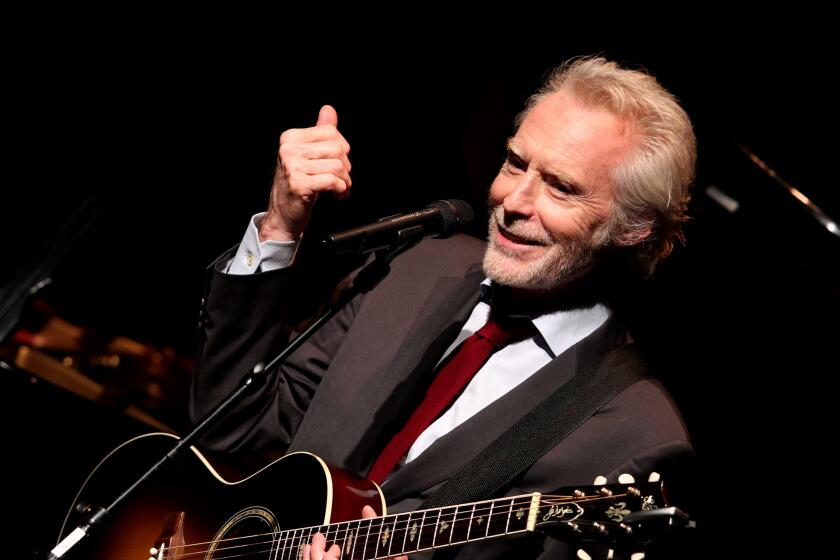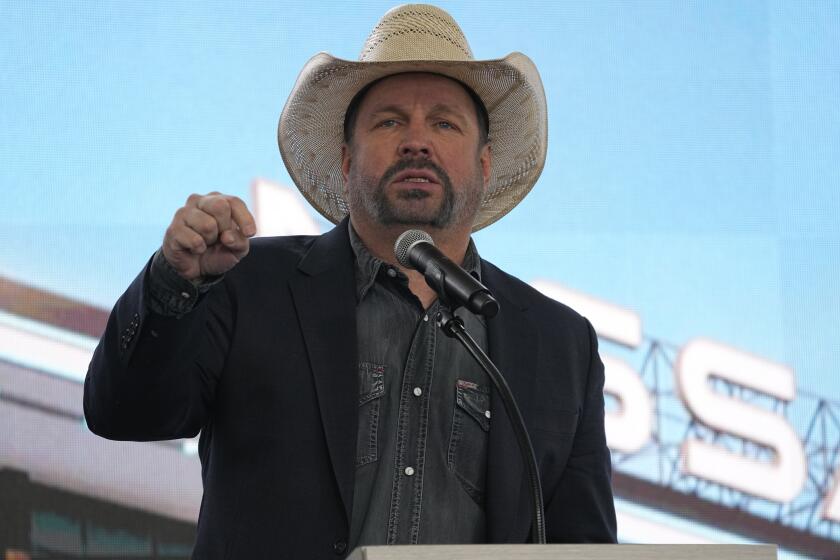Dwight Yoakam leans on vintage to inspire his new ‘Second Hand Heart’
“Man, I am burned,” Dwight Yoakam said as he poured coffee from a silver 7-Eleven thermos. “My throat — it’s just trashed.”
Bleary eyes fixed on a small monitor, the veteran Los Angeles-based country singer was sitting in an office on Hollywood Boulevard, editing footage for a music video for his song “Liar.” In the clip, Yoakam performs standing in the bed of a 1987 El Camino parked on Sunset Boulevard, and though the premise clearly excited him, the work of bringing it to the screen was taking a toll.
The night before, he had taped an episode of “Guitar Center Sessions” at the instrument store on Sunset. And the night before that he’d hit the Whisky a Go Go, yet another of the boulevard’s music-related landmarks, for a raucous concert marking the April 14 release of his new album, “Second Hand Heart.”
Of the Whisky gig, where he performed tunes from “Second Hand Heart” for the first time since recording the album, Yoakam, 58, laughed and said, “It was like coming down the backside of Coldwater Canyon with no brakes.” Even so, the show, like everything he’d done over the last few days, felt significant. “It all kind of bookends what I was doing at the beginning of my career.”
Memories of Yoakam’s scrappy early days on the L.A. club circuit — including a record-release show he played at the Roxy nearly 30 years ago to celebrate his debut album — course through “Second Hand Heart,” which roars with the punky guitars and headlong tempos this Kentucky native picked up from bands like X and the Dils after he moved here in the late ‘70s.
Yet the record is no mere nostalgia trip. It also reflects the influence Yoakam continues to have on younger country singers, along with his interest in their work (and, of course, their audiences).
Last fall he toured arenas opening for Eric Church. He joined Brandy Clark for a performance on February’s Grammy Awards. And as soon as he wrapped the “Liar” video he was set to travel to Dallas to appear with Sam Hunt at a concert connected to this month’s Academy of Country Music Awards.
“He still cares, and that’s unusual,” said Lenny Waronker, the longtime producer and Warner Bros. Records executive who’s worked with Yoakam on and off since 1986. “He wants his stuff to be as fresh and real and original as it can be.”
To capture the shiny but serrated sound of “Second Hand Heart,” Yoakam set up shop in a space he called one of the few remaining “magic gardens” from the golden era of recording in L.A.: Studio B at the Capitol Records building, where legends such as Nat King Cole and Frank Sinatra — not to mention country stars like Buck Owens and Merle Haggard — laid down some of their most important songs.
That history meant something to Yoakam, whose musical knowledge runs deep enough that he can expound for 15 minutes on the provenance of the studio’s linoleum floors. “But it’s not just deifying something because it’s old,” he insisted. “I mean, the Edsel is old, and I don’t want one. That car is an embarrassment.”
Instead, Yoakam was drawn to the room’s still-crisp acoustics — “Capitol B is a shrine because it tells you no lies,” he said — and to its famous reverb chambers.
Waronker said the result, with a triple-guitar attack that “just burns your ears,” is less “fancy” than “3 Pears,” the comparatively tender 2012 album that Yoakam recorded in part with Beck. And he’s right: Where the earlier disc cushioned songs about hope with stately roots-pop arrangements, “Second Hand Heart” gets back in the dirt both sonically and thematically.
Consider that on “3 Pears” Yoakam affectionately covered the Bee Gees’ “To Love Somebody,” while the new album has a blistering version of the folk standard “Man of Constant Sorrow” that the singer described as “Bill Monroe meets the Ramones.”
Which isn’t to say that one record represents the real Dwight Yoakam more than the other. Often hidden beneath his signature cowboy hat, the singer has always been a somewhat mysterious figure, a guy who uses his art as much to construct a self as to reveal one. (No surprise that he’s also made for a convincing character actor in movies like “Sling Blade” and “Panic Room.”)
“Dwight said something to me the first time I met him that I’d never heard anyone say,” recalled Clark, who also traveled as an opening act on Church’s 2014 tour. “I asked him what was his favorite record that he’d made, and he said, ‘All of them.’ ”
His reply struck Clark as an indication that Yoakam “can look back on his body of work and love it all but also not be stuck on any of it.”
That’s one reason that Yoakam, even when he’s invoking his past, ranks among the most modern of country stars — and one well suited, at least in theory, to younger fans untroubled by the idea of a mutable artistic persona. If Taylor Swift owes Yoakam for anything, it’s laying the groundwork that enabled her ongoing reinvention.
Peering out from the stage every night on the Church tour, Yoakam said he saw visual proof that country music’s “demographic paradigm has shifted dramatically,” away from the middle-aged listeners who historically formed the genre’s core audience toward fans in their late teens and 20s.
“It’s the youngest crowd since probably 1954 and ‘55, with Elvis Presley,” he said. “We’re talking about people literally fresh to country music within the past two, three years.”
And though that trend might worry some older performers, Yoakam views it as a source of motivation.
“I think it’s incumbent on artists my age to re-inspire themselves,” he said as he returned his attention to his video. “Maybe that will inspire a contemporary listener to want to pay attention to what you’re doing.
“Music is a state of continuous discovery,” he added. “Or it should be.”
Twitter: @mikaelwood
More to Read
The biggest entertainment stories
Get our big stories about Hollywood, film, television, music, arts, culture and more right in your inbox as soon as they publish.
You may occasionally receive promotional content from the Los Angeles Times.











